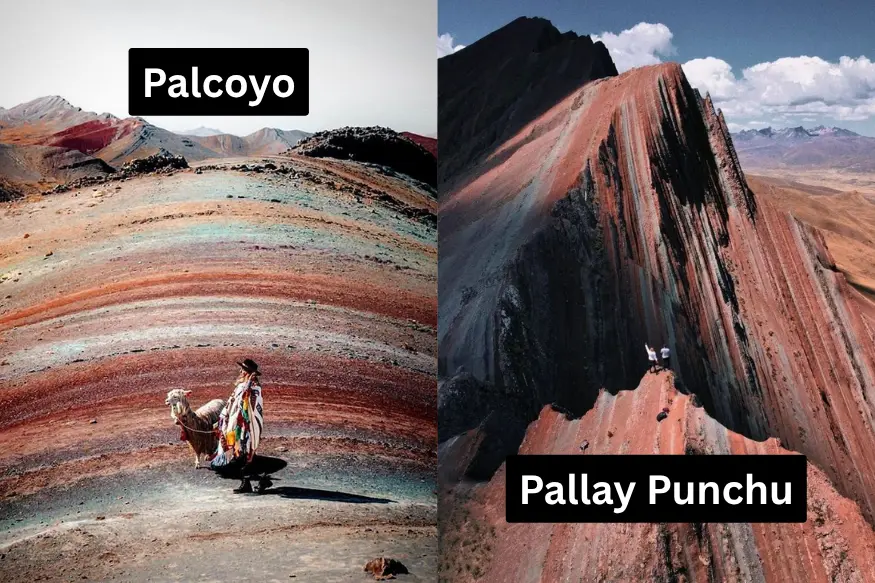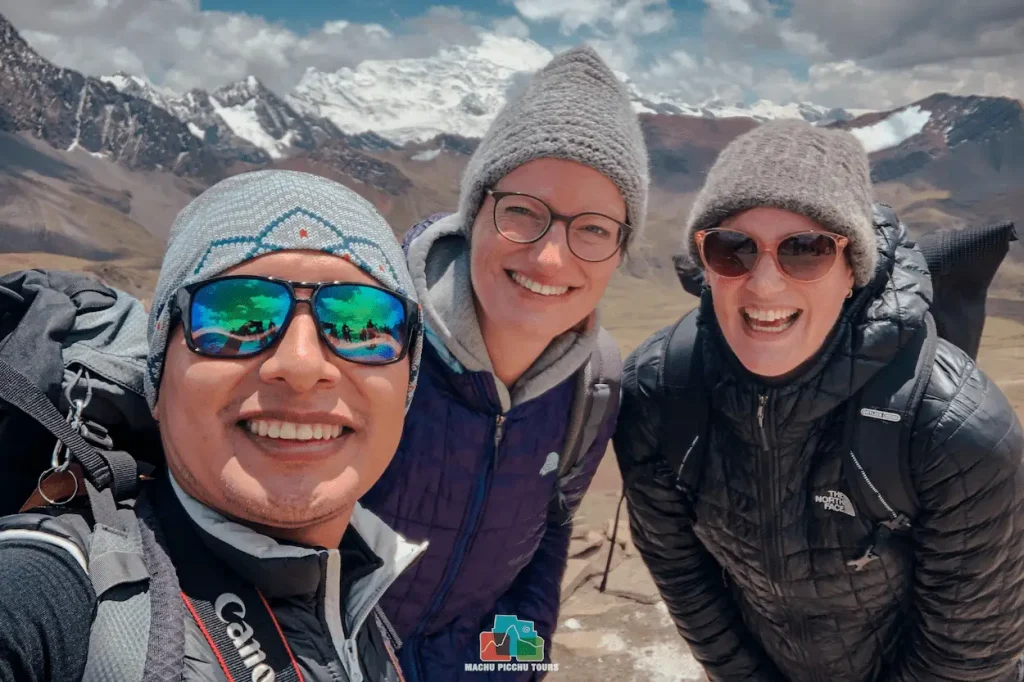Palcoyo vs Pallay Punchu: Which Rainbow Mountain Is Better to Visit?
High in the Peruvian Andes, south of Cusco, lie two incredible natural wonders that rival the famous Vinicunca Rainbow Mountain: Palcoyo and Pallay Punchu. Though both feature the stunning multicolored strata that give these peaks their iconic look, each offers a completely different experience.
In this complete guide — focused on the main keyword Palccoyo vs Pallay Punchu — you’ll discover everything you need to know before choosing which mountain to visit. We’ll compare location, altitude, accessibility, hiking difficulty, highlights, photography potential, and traveler experiences, so you can decide which one suits your travel style best.

What Are Palcoyo and Pallay Punchu?
Palccoyo Rainbow Mountain
Palccoyo is a breathtaking natural formation located in the district of Checacupe, in the southern highlands of Cusco, Peru. Rising to an altitude of about 4,900 meters (16,076 ft) above sea level, it features three distinct rainbow-colored peaks instead of just one, surrounded by spectacular landscapes.
What makes Palccoyo unique is not only the colorful mountains themselves, but also the “Stone Forest” — a group of tall rock spires shaped by erosion over millions of years — and the nearby Red Valley, whose crimson hills contrast beautifully with the multicolored slopes.
Unlike Vinicunca, which requires a steep 1.5-hour climb, Palccoyo’s trail is short and gentle, making it accessible to travelers of all ages and fitness levels.
Pallay Punchu Mountain
Pallay Punchu, often translated from Quechua as “the colorful poncho,” is another recently discovered rainbow mountain located in the district of Layo, province of Canas, in southern Cusco. Its sharp ridges and vivid mineral layers resemble the woven patterns of a traditional Andean poncho, which inspired its name.
This mountain sits slightly lower than Palccoyo, at around 4,700 meters (15,420 ft). What makes it truly distinctive is the dramatic jagged terrain and the view over Lake Langui, one of the most beautiful high-altitude lakes in Peru.
Still relatively unknown, Pallay Punchu offers a raw, off-the-beaten-path adventure far away from tourist crowds.
Location and How to Get There
Getting to Palccoyo
-
Location: Checacupe district, Canchis province, Cusco region.
-
Altitude: Approximately 4,900 m (16,076 ft).
-
Distance from Cusco: About 100 km (62 mi).
-
Travel time: Around 3 hours by car from Cusco to the trailhead.
The route to Palccoyo passes through small Andean towns like Combapata and Checacupe before climbing toward the colorful peaks. From the parking area, it’s just a short, scenic walk to the first viewpoint. The road is mostly paved, with the final section on dirt — but still in good condition.
Because Palccoyo is becoming increasingly popular, you’ll find day tours departing Cusco daily, or you can hire private transport if you prefer to travel independently.
Getting to Pallay Punchu
-
Location: Layo district, Canas province, Cusco region.
-
Altitude: Approximately 4,700 m (15,420 ft).
-
Distance from Cusco: About 130 km (80 mi).
-
Travel time: Roughly 4 to 4.5 hours from Cusco to the starting point.
The road to Pallay Punchu is longer and passes through rural areas with less tourist infrastructure. You’ll travel south along the highway to Sicuani, then continue toward Layo and Lake Langui before reaching the base of the mountain.
Because of its remoteness, organized tours are less frequent, and public transportation options are limited — but that’s precisely what makes Pallay Punchu so special: few tourists and pristine landscapes.
Hiking Difficulty and Trail Details
Palccoyo Hike
-
Total hiking time: 45 minutes to 1 hour to the viewpoint.
-
Difficulty: Easy to moderate.
-
Elevation gain: About 150 meters (492 ft).
-
Trail condition: Well-marked, wide, and not steep.
The Palccoyo hike starts at an altitude of around 4,800 m and follows a gentle slope to the main viewpoint. Along the way, you can stop at several observation points overlooking the colored peaks, alpaca herds, and the Red Valley.
Because the hike is short and gradual, Palccoyo is ideal for families, casual travelers, or anyone not fully acclimated to high altitude. However, it’s still important to take it slow and stay hydrated, as the air is thin at nearly 5,000 m.
Pallay Punchu Hike
-
Total hiking time: 1 to 1.5 hours (depending on fitness and weather).
-
Difficulty: Moderate.
-
Elevation gain: Around 250 meters (820 ft).
-
Trail condition: Dirt path, some steep sections, rugged terrain.
The Pallay Punchu trail begins near Lake Langui and climbs along a steep ridge toward the jagged rainbow mountain. The path is less developed than Palccoyo’s and includes rocky stretches, so good hiking shoes are essential.
Although it requires a bit more effort, the reward is immense: panoramic views of the colorful cliffs and the serene blue lake below. Because of the remoteness, you’ll often find yourself completely alone in the mountains — a rare luxury in today’s world.
Natural Highlights and Unique Features
Highlights of Palccoyo
-
Three rainbow mountains: Unlike Vinicunca, Palccoyo features multiple colorful ridges in close proximity.
-
The Stone Forest: Towering rock formations created by natural erosion, perfect for photography.
-
The Red Valley: A surreal landscape of crimson and ochre hills nearby.
-
Llamas and alpacas: You’ll often encounter herds grazing freely along the slopes.
-
Panoramic viewpoints: Wide-angle views of the Andes and snow-capped peaks in the distance.
Highlights of Pallay Punchu
-
Sharp rainbow ridges: The mountain’s distinctive blade-like shape makes it stand out among other rainbow mountains.
-
Lake Langui: A large turquoise lake visible from the summit, offering stunning contrast in your photos.
-
Cultural symbolism: “Pallay Punchu” means “decorated poncho,” linking the mountain to Andean weaving traditions.
-
Off-the-beaten-path adventure: Almost no crowds, giving a deep sense of peace and authenticity.
-
Unspoiled nature: Wild vicuñas, eagles, and other Andean wildlife can sometimes be spotted.
Palcoyo vs Pallay Punchu: Direct Comparison
| Feature | Palccoyo | Pallay Punchu |
|---|---|---|
| Altitude | 4,900 m (16,076 ft) | 4,700 m (15,420 ft) |
| Distance from Cusco | ~100 km / 3 hours | ~130 km / 4–4.5 hours |
| Difficulty | Easy to moderate | Moderate |
| Hiking time | 45–60 minutes | 60–90 minutes |
| Trail type | Smooth, accessible | Rugged, steeper |
| Crowds | Light | Very few or none |
| Extra attractions | Stone Forest, Red Valley | Lake Langui, jagged ridges |
| Ideal for | Families, casual hikers | Adventurous travelers |
| Best photo ops | Wide panoramic landscapes | Sharp rainbow peaks with lake backdrop |
In short:
-
Choose Palccoyo if you want ease, comfort, and accessibility.
-
Choose Pallay Punchu if you seek isolation, adventure, and unique landscapes.
Palcoyo vs Pallay Punchu: Weather, Altitude, and the Best Time to Visit
Both Palccoyo and Pallay Punchu lie in the high Andes, meaning conditions can change quickly — from bright sunshine to hail in minutes.
-
Dry season (April – October): Best time to visit. Clear skies and vibrant colors.
-
Rainy season (November – March): Expect clouds, fog, and muddy trails, though the colors may appear richer after rainfall.
-
Temperature: Daytime highs 10–15 °C (50–59 °F), nighttime lows can drop below freezing.
Because of the high altitude, it’s essential to acclimatize in Cusco for 1–2 days before doing either hike. Drink coca tea, avoid alcohol, and walk slowly to reduce the risk of altitude sickness.
Cultural and Geological Significance
The Science Behind the Colors
The iconic rainbow hues come from layers of sedimentary rock rich in different minerals:
-
Red: iron oxide
-
Green: copper oxide
-
Yellow: sulfur compounds
-
White: quartz and sandstone
-
Pink/Purple: mixtures of hematite and magnesium
Over millions of years, tectonic movements and erosion exposed these strata to the surface, creating the mesmerizing striped patterns we see today.
Andean Culture and Traditions
Both Palccoyo and Pallay Punchu are located in Quechua-speaking communities that still maintain their ancestral way of life — herding llamas and alpacas, weaving textiles, and practicing traditional rituals to honor the Apus (mountain spirits).
When you visit, you’ll often see locals wearing colorful ponchos, which visually echo the rainbow mountains themselves — a beautiful reflection of the harmony between people and landscape.
Travel Logistics and Practical Tips for Palcoyo and Pallay Punchu
What to Bring
-
Warm layered clothing: Temperatures fluctuate quickly.
-
Water and snacks: Especially for Pallay Punchu, where shops are scarce.
-
Sun protection: Sunglasses, sunscreen, and hat.
-
Camera or drone: The landscapes are jaw-dropping.
-
Cash: Small bills for entrance fees or local souvenirs.
-
Trekking shoes: Essential for rocky sections.
Health and Safety Tips
-
Spend at least two nights in Cusco before the hike.
-
Walk slowly and rest often; oxygen levels are low.
-
Stay hydrated — drink 2–3 liters of water per day.
-
Consider bringing coca leaves or altitude medication.
-
Respect local communities and avoid littering.
Entrance Fees
Both mountains charge a small entrance fee (usually between 10–20 soles, less than $5 USD). This money supports the local communities that maintain the trails.
Tours vs Independent Travel
-
Palccoyo: Many daily tours from Cusco (around 10–12 hours total). Includes transport, guide, and lunch.
-
Pallay Punchu: Fewer organized tours; best arranged with a local operator or private driver.
Photography and Visual Experience
Palccoyo Photography Tips
-
Arrive early for softer morning light and fewer visitors.
-
Wide-angle lenses capture the full panorama of multiple colored mountains.
-
The Stone Forest offers unique textures for creative shots.
-
On clear days, you can even spot the Ausangate glacier in the distance.
Pallay Punchu Photography Tips
-
The jagged rainbow ridges and blue lake create perfect contrast.
-
The best lighting is around midday, when the sun illuminates the slopes.
-
Bring a polarizing filter to reduce glare from the lake surface.
-
Drones are permitted in most areas — always check with your guide first.
Both mountains offer some of the most photogenic landscapes in Peru, but Pallay Punchu has the edge for dramatic composition due to its ridge lines and lake views.
Environmental Awareness
As tourism grows, preserving these delicate ecosystems becomes crucial. When visiting either Palccoyo or Pallay Punchu:
-
Stay on marked trails to avoid damaging fragile soil.
-
Take all trash back to Cusco.
-
Avoid touching or collecting rocks.
-
Support local guides and communities.
-
Travel in small groups when possible.
By practicing responsible tourism, you help ensure that future generations can experience the same beauty.
Palcoyo vs Pallay Punchu Which One Should You Choose?
Choose Palccoyo if:
-
You want an easier, family-friendly hike.
-
You prefer comfort and better road access.
-
You’re short on time but still want to see rainbow mountains.
-
You enjoy panoramic landscapes and geological formations.
Choose Pallay Punchu if:
-
You crave adventure and solitude.
-
You want to escape mass tourism completely.
-
You’re comfortable with longer drives and steeper trails.
-
You’re a photographer or nature lover seeking unique perspectives.
Ultimately, both destinations are spectacular. The decision depends on your fitness level, travel style, and what kind of Andean experience you’re after.

Palcoyo Rainbow Mountain Tour from Cusco is the perfect way to explore one of Peru’s most colorful natural wonders without the crowds. Located in the heart…
Palccoyo vs Pallay Punchu
When comparing Palccoyo vs Pallay Punchu, there’s no absolute winner only the mountain that best fits your travel personality.
-
Palccoyo offers accessibility, comfort, and stunning yet gentle landscapes.
-
Pallay Punchu offers raw beauty, solitude, and the thrill of discovery.
Both are far less crowded than Vinicunca and deliver unforgettable views of the Peruvian Andes’ geological artistry.
Whichever you choose, visiting these colorful mountains will connect you deeply with the energy of the Andes a place where the Earth itself seems to paint with light.
